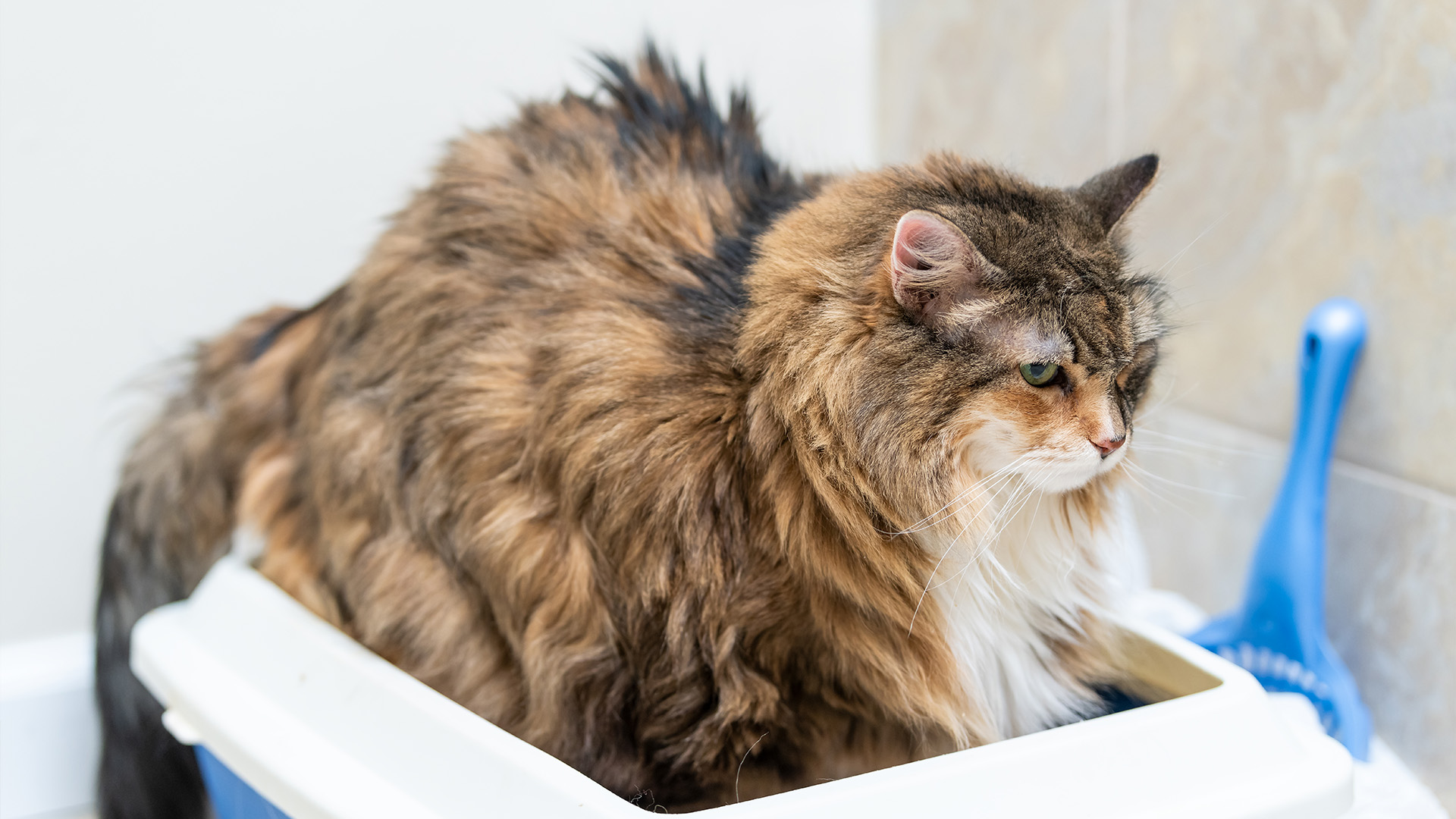
Unfortunately, cat constipation is pretty common. There are many possible causes, ranging from lifestyle factors to medical conditions. Constipation can be surprisingly hard to spot in cats since the symptoms can easily be confused with other issues.
Considering how important early treatment and management are, it is key that you know what to look out for. Without early treatment, constipation can lead to other problems and is more likely to recur. So, let’s take a look at everything you should know about constipation in cats.
What is cat constipation?
Constipation means difficulty passing poo (faeces or stools), passing poo infrequently, or not passing poo at all.
In cat constipation, the faeces are held in the large intestine (the colon and rectum), where they build up. Since one of the major functions of the colon is to absorb water from the stools, and it continues to do so while the stool is held in the colon, the stools get drier and harder with time. This makes it even harder for them to pass.
When constipation becomes a chronic (long-term) problem, meaning the colon is being stretched over a period of time, this can lead to a condition called ‘megacolon’. With megacolon, the colon is stretched too large, making it unable to effectively push the faeces out.
Causes of cat constipation
There are lots of possible causes for cat constipation, ranging from factors in the environment to serious medical conditions. Possible causes include:
1. Environmental factors
Cats are fussy creatures, so if they are used to pooing outside and need to be kept in, they may refuse to use a litter tray. Similarly, cats may take a dislike to a certain type of litter or tray, causing them to hold their stool while they wait for an alternative.
A dirty tray or having to share a litter tray can also be off-putting to our feline friends. Since water is continually drawn from the stool by the colon, the longer they wait, the drier and harder the stool becomes. Read our feature on how often to clean litter boxes if you aren’t sure.
Finding the best cat litter for your feline friend – and perhaps experimenting with different types of cat litter – will help them feel more comfortable when using the restroom.
2. Dehydration
Dehydration in cats causes the body to conserve as much water as possible. This means it re-absorbs as much water from the stools as possible, making them hard and dry. Because of this, constipation is cvommon in medical conditions such as Chronic Kidney Disease (CKD).
3. A blocked colon
A blockage in the colon caused by a foreign body (i.e. the cat has eaten something it shouldn’t have), a polyp or a mass can cause constipation by physically blocking the stool from passing. A build-up of hairballs can have the same effect!
A colon can also become blocked if the pelvic canal (the internal area between the hip bones) becomes narrowed for any reason, such as following a trauma like a road traffic accident.
4. Pain
Anything that makes it painful to go to the toilet can cause a cat to become constipated. They realise that passing a stool will hurt, so are reluctant to go. Arthritis can make posturing to poo painful, for example.
5. Neurological conditions
If the nerves controlling the passing of faeces are damaged, for example in a ‘tail pull’ injury or after a road traffic accident, this can cause constipation (or on the flip side it can also cause incontinence).
6. Idiopathic megacolon
Megacolon isn’t always caused by chronic constipation and sometimes occurs as a condition with an unknown cause. The wall of the distended colon is weak and unable to push faeces out.
Now that we know what might cause cat constipation, let’s take a look at how to tell if your cat is constipated.
Signs of cat constipation

The symptoms will vary, and can mimic other problems, such as straining to wee. The main symptoms of constipation are:
- Straining to poo, often with signs of pain
- Passing stools less often
- Multiple trips to toilet outside, or to the litter tray, without passing anything
- Small, dry nuggets of cat poop
- Small amounts of liquid stool (which are easy to confuse with diarrhea, but are actually liquid stool managing to pass around the build-up of faeces).
You may also notice:
- Lethargy (lack of energy)
- Decreased appetite
- Vomiting
Is cat constipation an emergency?
This depends a little on the cause. Cats normally poo every day, so at least once every 24 hours. If your cat hasn’t passed stools in the past 48 hours (or more), then it’s time for an urgent trip to your vet! The best automatic cat litter boxes can actually track this for you, so are worth investigating if you’re worried – especially if you have multiple cats and can’t tell who’s been.
If your cat is making frequent trips to the litter tray but not passing anything, it’s really important to be sure they aren’t actually trying to wee. If you aren’t sure if your cat is weeing, then you should call your vet straight away. Straining to pass urine, without actually passing any, can be a sign of a blocked bladder, which is a life-threatening emergency.
How is cat constipation treated?
The treatment will partly depend on the severity and the cause. In severe or chronic cases, a constipated cat will need to have fluid therapy and manual removal of the faeces under a general anaesthetic. For less severe cases there are several medical options, including:
- Enemas
- Laxatives
- Prokinetics (which stimulates the colon to contract, to squeeze the stools out)
In severe cases, surgery is sometimes needed to remove a large portion of the colon. This is usually a last resort.
Your vet may also advise you to continue treating cat constipation at home. This ongoing management may involve medication, alongside:
- Ensuring they drink enough water: using water fountains and feeding wet food, for example
- Regular grooming to help prevent furballs, especially in longhaired cats
- Litter tray attention: for example ensuring the tray is always clean, using the best cat litter box and a litter your cat likes and ensuring you have one litter tray per cat, plus one extra.
Your vet may also advise you to change your cat’s diet or recommend some home remedies for cat constipation.
What to feed a cat with constipation
Cats with constipation usually need a high fibre diet, although this is not always the case. Due to the amount, and types, of fibre in some of the foods we might eat to naturally increase our fibre intake (such as pumpkin), these foods are not generally recommended for cats. The amount you would need to feed to make a difference is usually unrealistic – and remember that there are some human foods that are poisonous to cats. Instead, your vet will be able to recommend a high-fibre diet or a fibre food additive (like this one on Amazon). The best wet cat foods are also beneficial in constipation, to help your cat stay hydrated.
Got questions about kitten constipation? Read our expert vets’ advice
Edited by Georgia Guerin.







